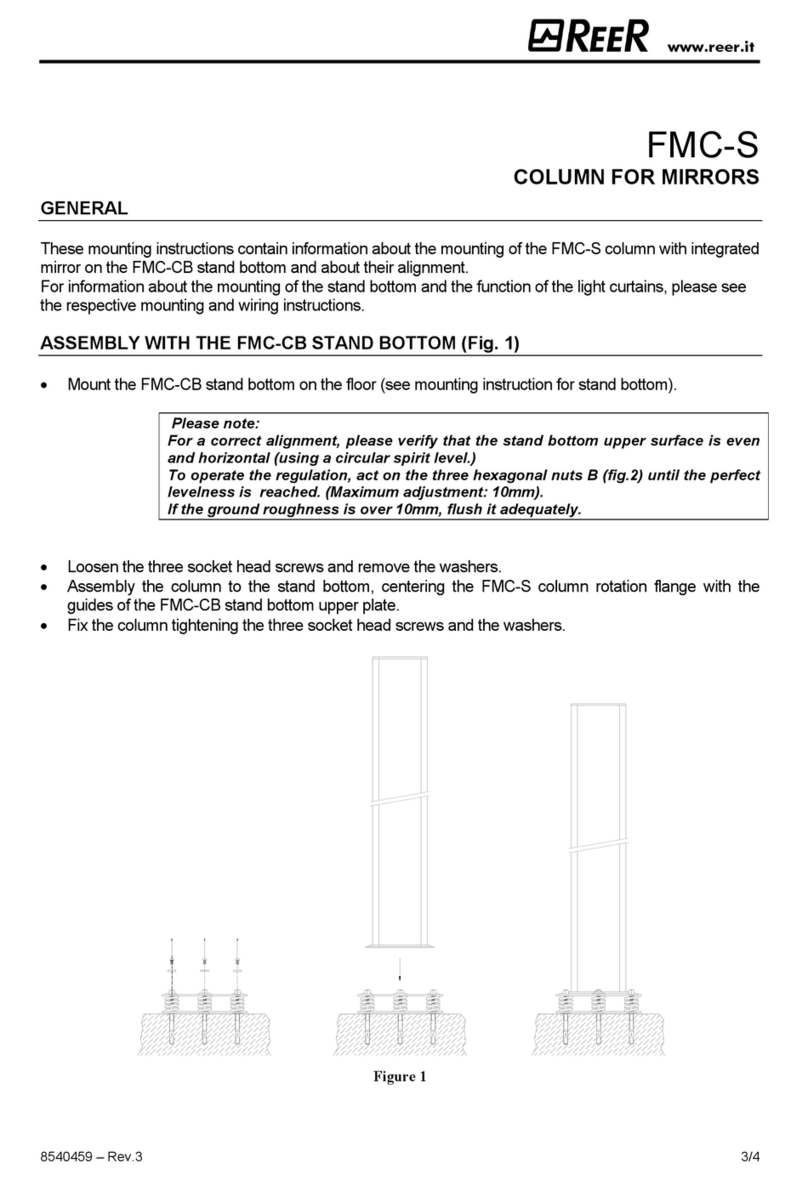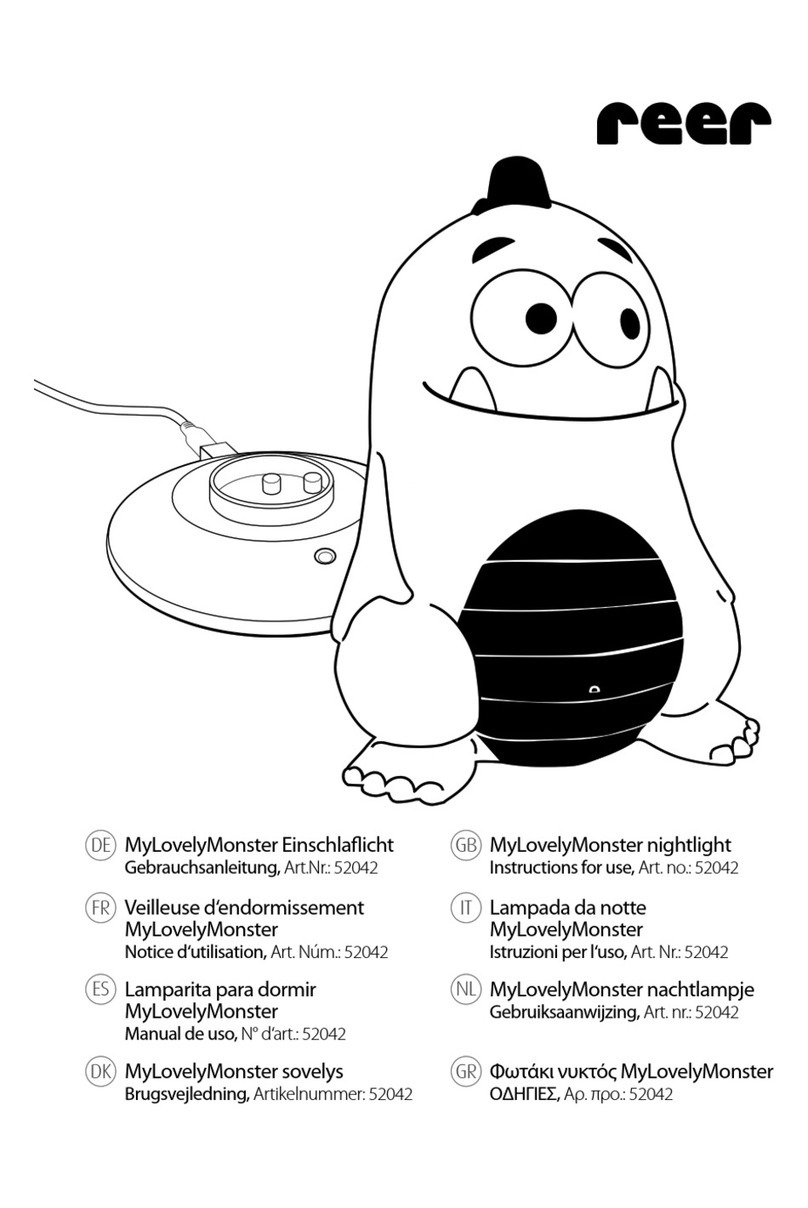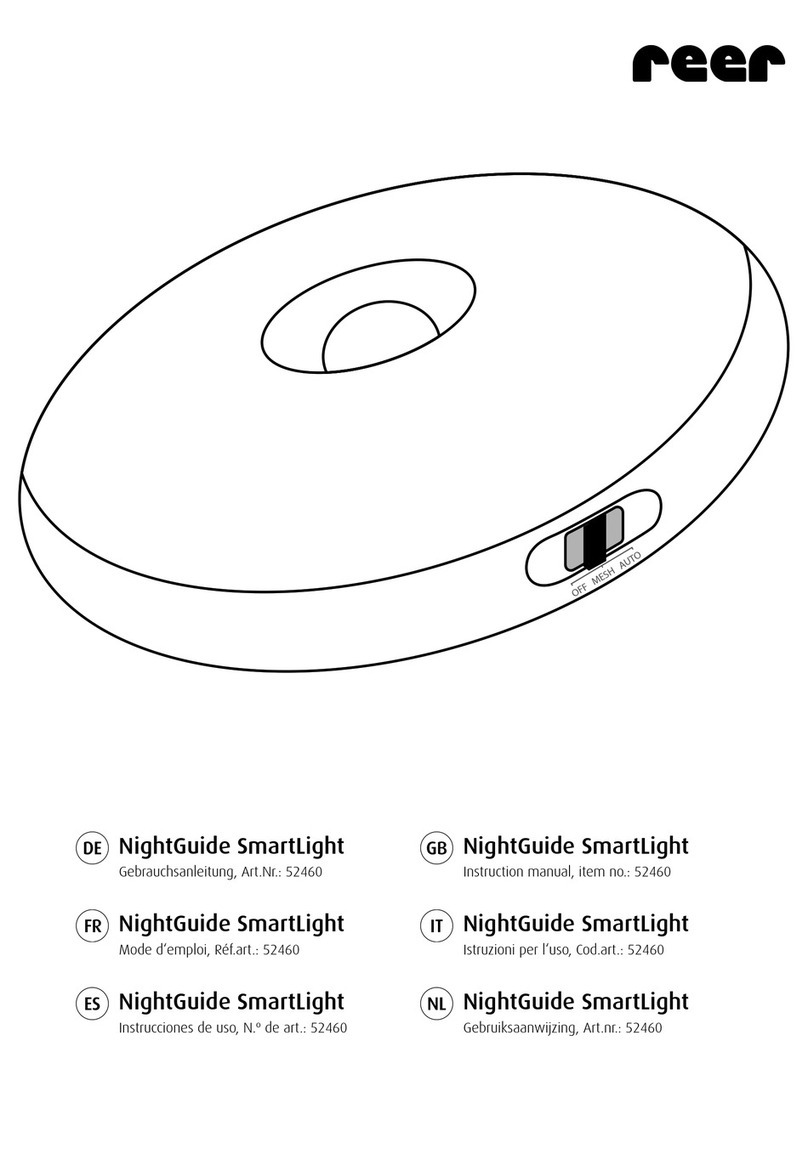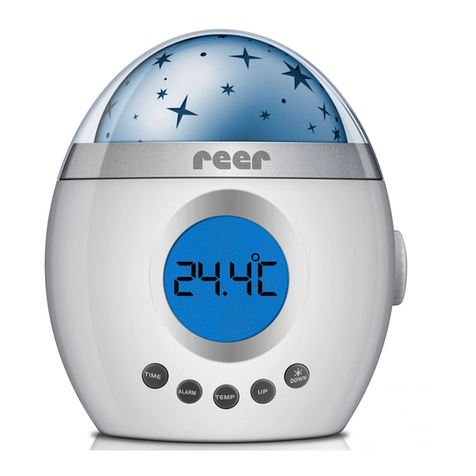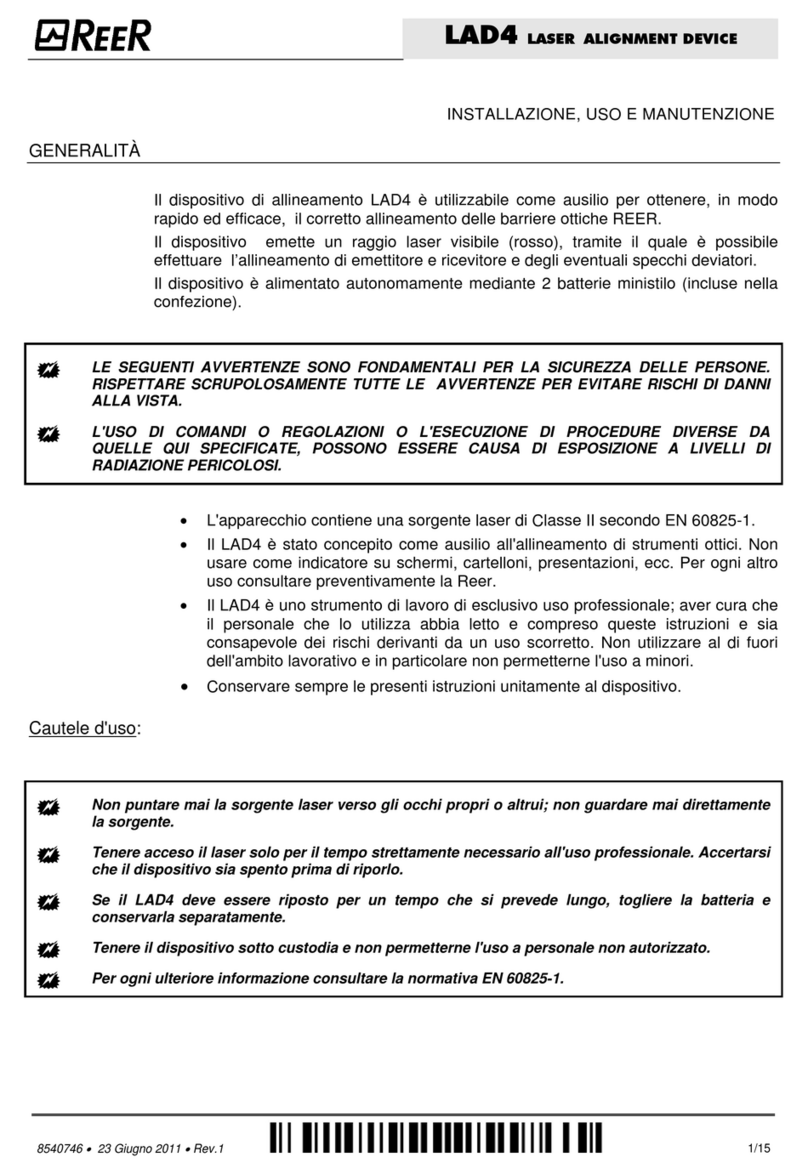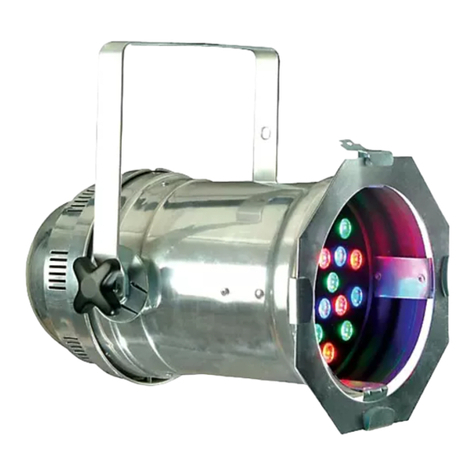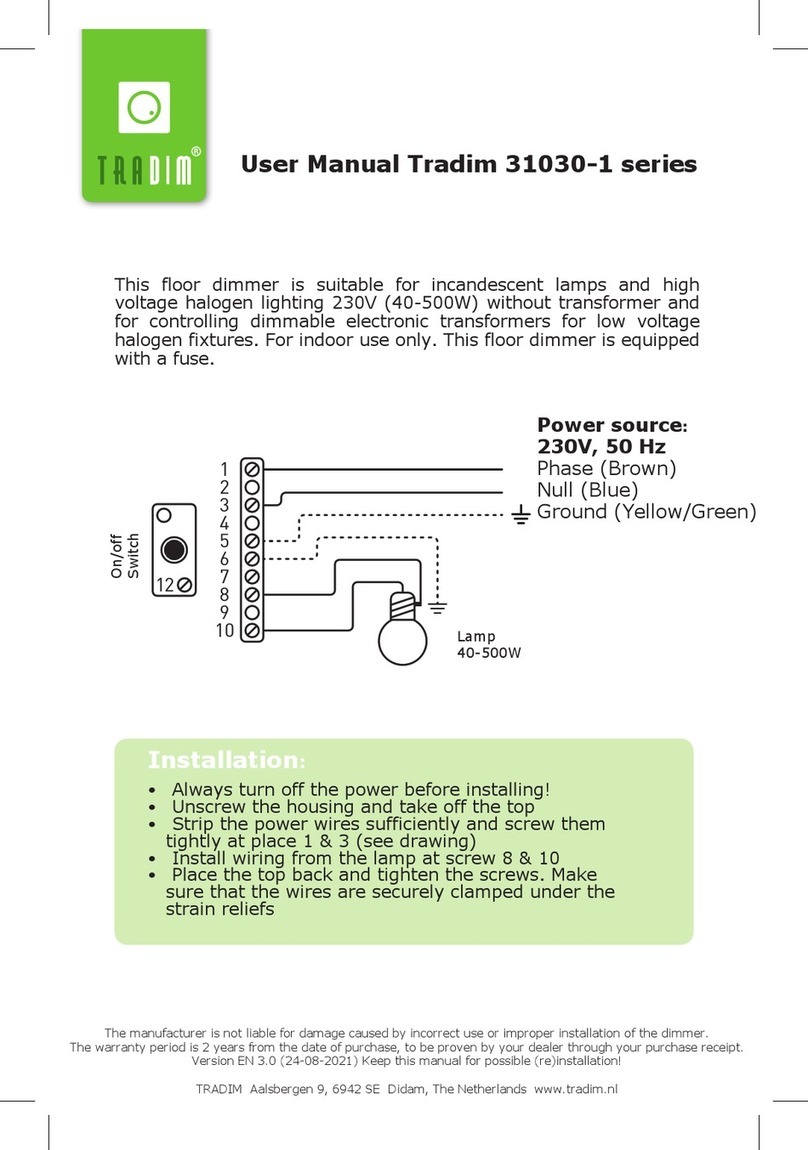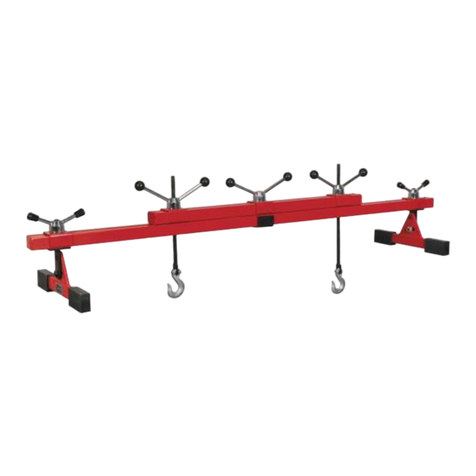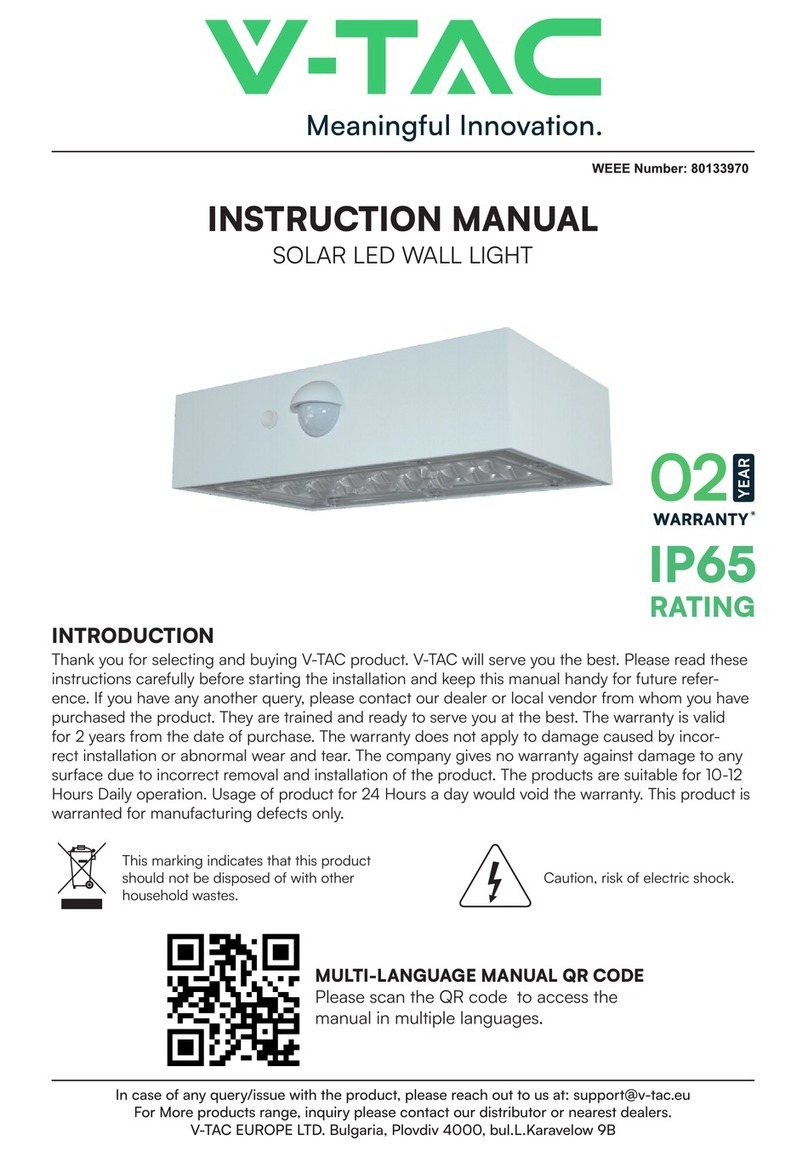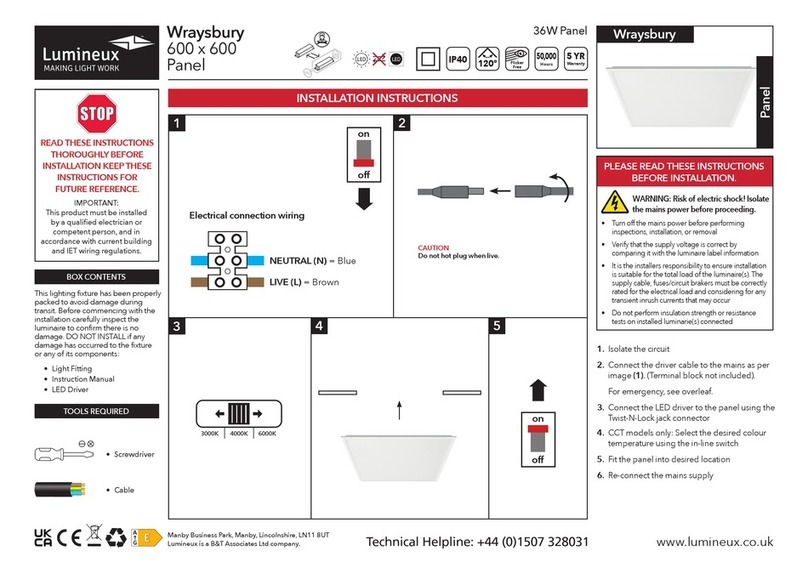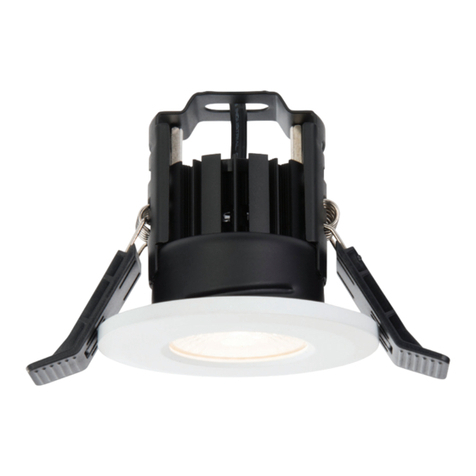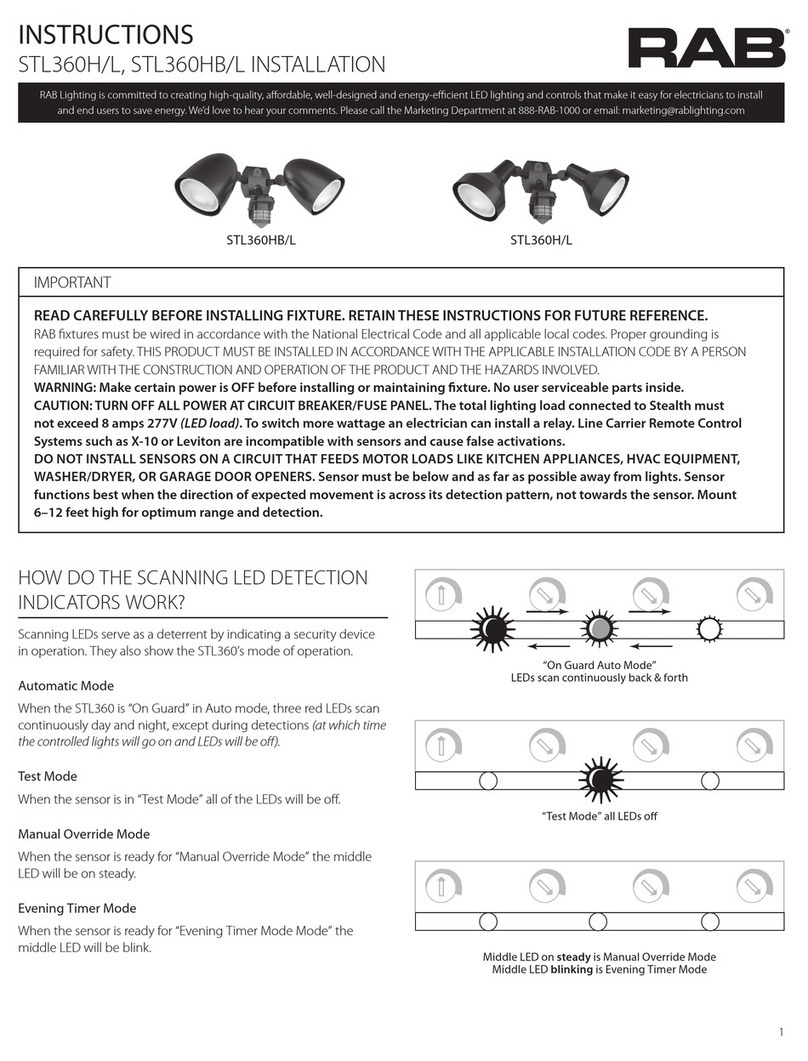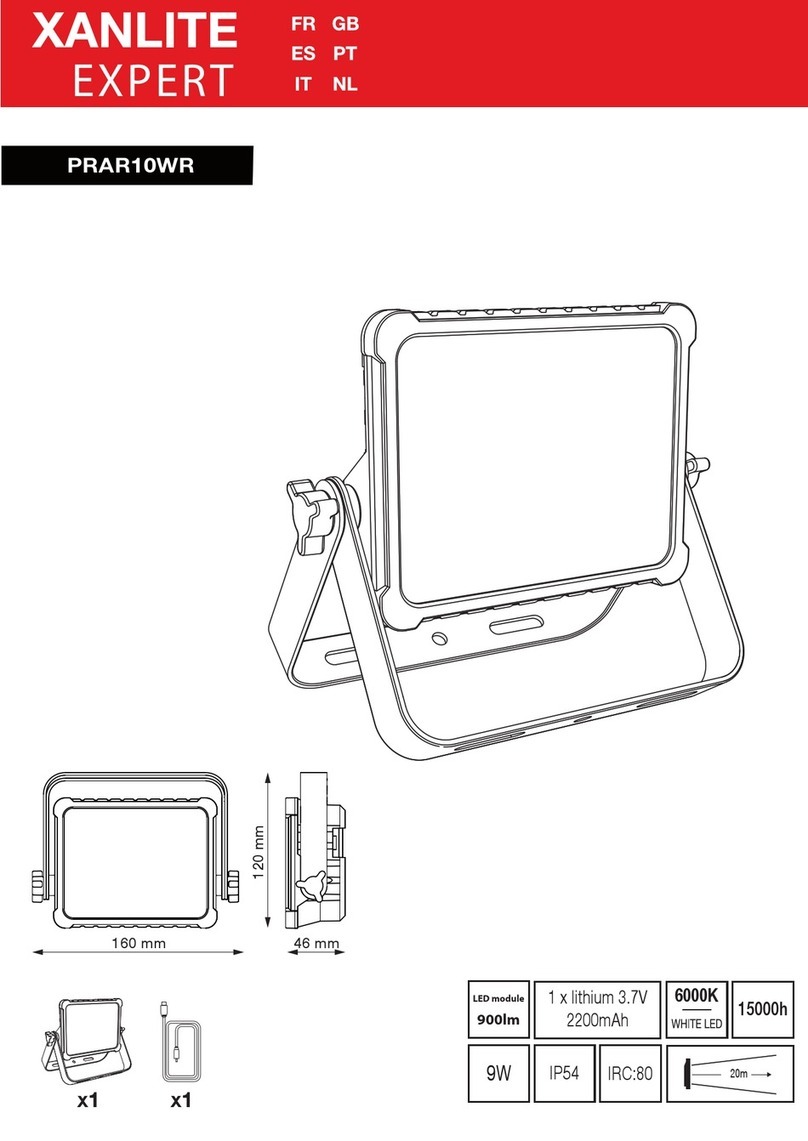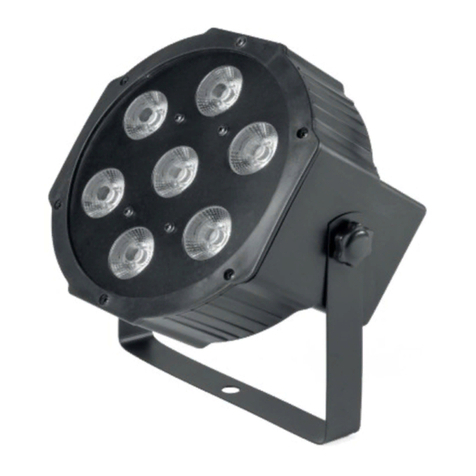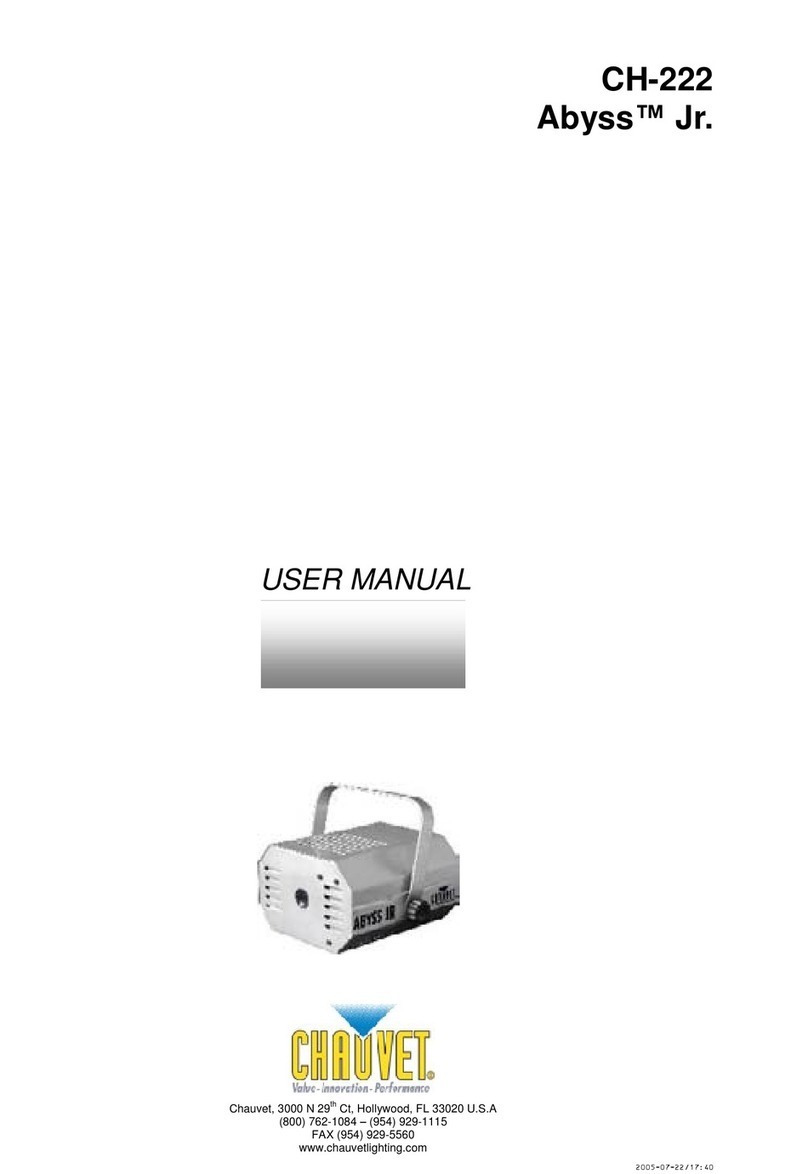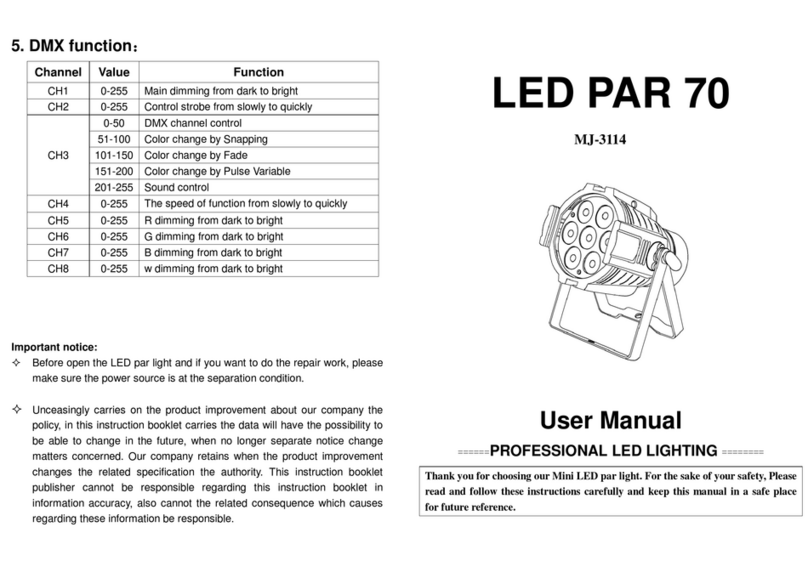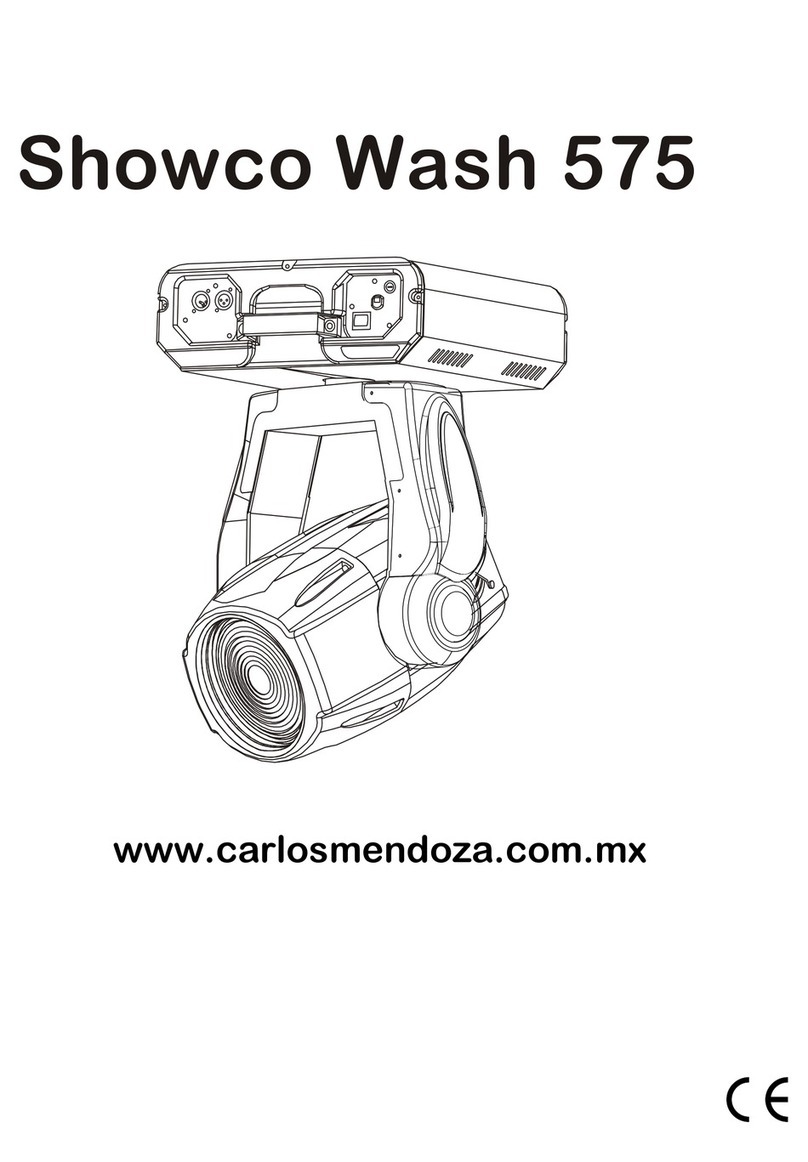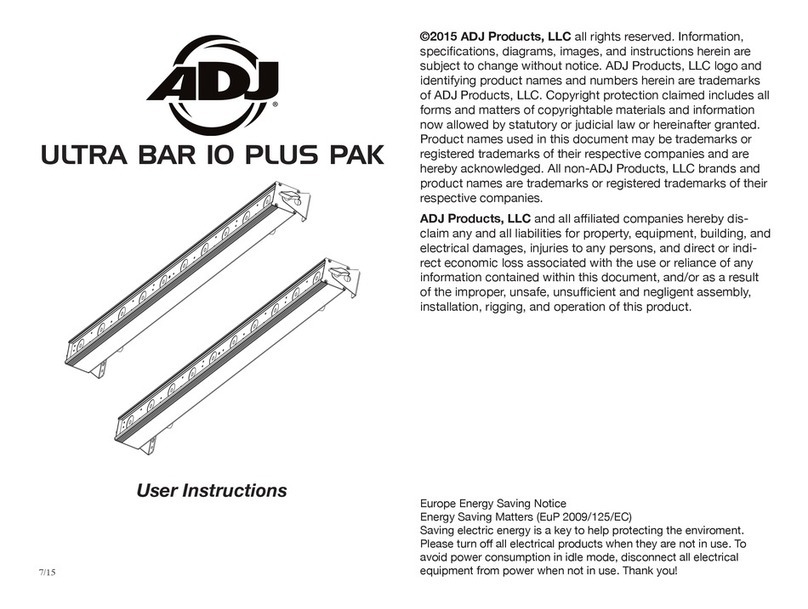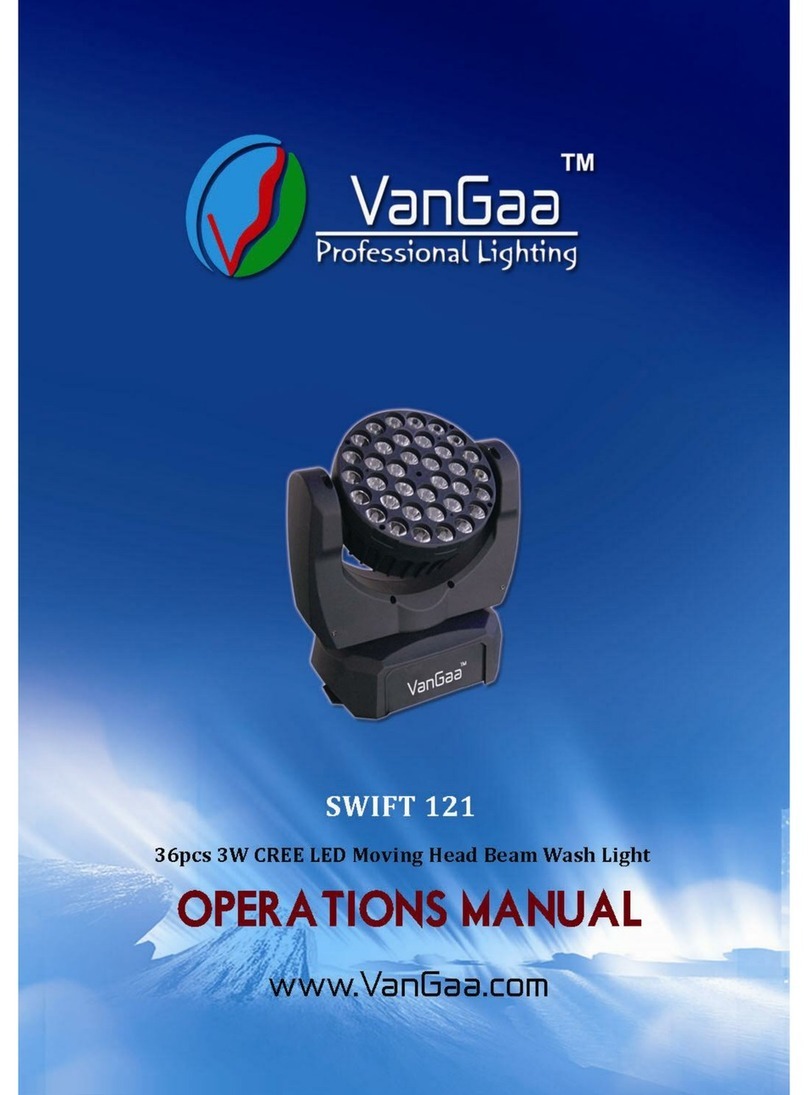Reer VISION Instruction manual

7
FUNZIONAMENTO E DATI TECNICI
SEGNALAZIONI
LED COLORE STATO CONDIZIONE
1 Giallo Acceso
2 Rosso Acceso Accensione sistema. TEST iniziale.
1 Giallo Acceso
3 Verde Acceso Condizione di TEST
Emettitore
3 Verde Acceso Funzionamento normale
LED COLORE STATO CONDIZIONE
4 Giallo Acceso
5 Rosso Acceso
6 Rosso Acceso Accensione sistema.
7 Verde Acceso Area protetta libera.
5 Rosso Acceso Area protetta occupata.
Ricevitore
4 Giallo Acceso Segnale ricevuto debole
NOTA: Per una descrizione delle segnalazioni in caso di FAIL, consultare il paragrafo
“DIAGNOSI GUASTI” del presente manuale (pagina 23).
Figura 16
ÎNei modelli Multibeam, è presente sull’emettitore un led rosso in corrispondenza
di ogni raggio, in modo tale da consentirne una facile individuazione.

3
DIAGNOSI GUASTI
Le indicazioni fornite dai LED presenti sull’Emettitore e sul Ricevitore, permettono di isolare
la causa di un non corretto funzionamento del sistema.
Facendo riferimento alla figura 24, verificare le indicazioni fornite dai LED:
Figura 24
EMETTITORE
LED
Giallo (1) Rosso (2) Verde (3) DIAGNOSI RISOLUZIONE
OFF ON OFF
Anomalia di
funzionamento Inviare l’apparecchiatura in
riparazione presso i laboratori
REER

8540488
•
28/04/2005
•
Rev.4
RICEVITORE
LED
Giallo (4) Rosso (5) Rosso (6) Verde (7) DIAGNOSI RISOLUZIONE
Lamp.
VELOCE
ogni 0,5s ON Lamp.
VELOCE
ogni 0,5s OFF Guasto relativo alle
schede a
microcontrollore
Inviare l’apparecchiatura in
riparazione presso i laboratori
REER
OFF ON
Lamp.
VELOCE
ogni 0,5s OFF
Guasto alle uscite
statiche OSSD,
oppure uscite statiche
OSSD erroneamente
collegate a 24VDC
Verificare attentamente il
collegamento dei morsetti 2 e 4
(OSSD) presenti sul connettore.
Se non si risolve:
Inviare l’apparecchiatura in
riparazione presso i laboratori
REER
Lamp.
VELOCE
ogni 0,5s ON OFF OFF
Guasto alle schede
ottiche
Inviare l’apparecchiatura in
riparazione presso i laboratori
REER
OFF ON
Lamp.
LENTO
ogni 1s OFF
Assorbimento di
corrente eccessivo
sulle uscite OSSD o
uscite in corto circuito
tra di loro
Verificare attentamente il
collegamento dei morsetti 2 e 4
(OSSD) presenti sul connettore.
Tali morsetti potrebbero essere
direttamente collegati a
+24Vdc, a 0Vdc o cortocircuitati.
Lamp.
LENTO
ogni 1s ON OFF OFF
Rilevata condizione
pericolosa di
Emettitore interferente.
Il Ricevitore è in grado
di ricevere
contemporaneamente
i raggi emessi da due
diversi Emettitori.
Ricercare attentamente
l’Emettitore disturbante ed
intervenire in uno dei seguenti
modi :
•Scambiare la posizione di
Emettitore e Ricevitore
•Spostare l’Emettitore
interferente per evitare che
illumini il Ricevitore
•Schermare i raggi provenienti
dall’Emettitore interferente
mediante protezioni opache
In ogni caso, a fronte di un blocco del sistema, si consiglia uno spegnimento ed una
riaccensione, in modo da verificare che la causa del comportamento anomalo non sia
imputabile ad eventuali disturbi elettromagnetici di carattere casuale.
Nel caso sussistano irregolarità di funzionamento, occorre:
•controllare l'integrità e la correttezza delle connessioni elettriche;
•verificare che i livelli di tensione di alimentazione siano conformi a quelli
indicati nei dati tecnici;
•Si consiglia di tenere separata l'alimentazione della barriera da quella di altre
apparecchiature elettriche di potenza (motori elettrici, inverter, variatori di
frequenza) o altre fonti di disturbo.
•controllare che l’Emettitore e il Ricevitore siano correttamente allineati e che le
superfici frontali siano perfettamente pulite.
In caso non sia possibile identificare chiaramente il malfunzionamento e porvi
rimedio, fermare la macchina e contattare il servizio di assistenza ReeR.

5
Se i controlli suggeriti non sono sufficienti a ripristinare il corretto funzionamento del sistema,
inviare l'apparecchiatura ai laboratori REER, completa di tutte le sue parti, indicando con
chiarezza:
•codice numerico del prodotto (campo P/N rilevabile dall’etichetta di prodotto);
•numero di matricola (campo S/N rilevabile dall’etichetta di prodotto);
•data di acquisto;
•periodo di funzionamento;
•tipo di applicazione;
•guasto riscontrato.
ACCESSORI
MODELLO ARTICOLO CODICE

OPERATION AND TECHNICAL DATA
SIGNALS
LED COLOUR STATUS CONDITION
1 Yellow On
2 Red On System activated. Initial TEST.
1 Yellow On
3 Green On TEST condition
Emitter
3 Green On Normal operation
LED COLOUR STATUS CONDITION
4 Yellow On
5 Red On
6 Red On System activated
7 Green On Protected area clear
5 Red On Protected area engaged
Receiver
4 Yellow On Weak signal received
NOTE: For a description of the signalings in case of FAIL, please refer to the
“TROUBLESHOOTING” paragraph in this manual (page 23).
Figure 16
ÎOn the emitter of the multibeam models, near each beam, is present a red led
which permits an easy detection of the beam.
EMITTER RECEIVER

TROUBLESHOOTING
The instructions provided by the LEDs of the Emitter and the Receiver enable the user to
identify the cause of a number of system malfunctions.
Refer to figure 24 to verify the LEDs indications.
Figure 24
EMITTER
LED
Yellow (1) Red (2) Green (3) DIAGNOSIS REMEDY
OFF ON OFF
Anomalous operation Return the equipment to
ReeR laboratories for repair.
EMITTER RECEIVER

RECEIVER
LED
Yellow(4) Red (5) Red (6) Green (7) DIAGNOSIS REMEDY
Blinking
FAST
every 0,5s ON Blinking
FAST
every 0,5s OFF Internal failure relating
to the microcontroller
boards
Return the equipment to ReeR
laboratories for repair.
OFF ON
Blinking
FAST
every 0,5s OFF
Internal failure relating
to the static outputs
(OSSD), or erroneous
connection of static
outputs (OSSD).
Check the connection of terminals
2 and 4 (OSSD) on the connector
carefully. If no remedy is
achieved:
Return the equipment to ReeR
laboratories for repair.
Blinking
FAST
every 0,5s ON OFF OFF
Internal failure relating
to the optical boards Return the equipment to ReeR
laboratories for repair.
OFF ON
Blinking
SLOW
every 1s OFF
Overcurrent on one or
both outputs (OSSD)
or
Probable short circuit
between the two
outputs (OSSD)
Check the connection of terminals
2 and 4 (OSSD) on the connector
carefully. If necessary, reduce the
load by reducing the requested
current to max. 500mA (2.2 µF).
These terminals can be connected
directly to + 24 Vdc or to 0 Vdc or
in short circuit.
Blinking
SLOW
every 1s ON OFF OFF
Detection of a
hazardous interfering
Emitter condition. The
Receiver is able to
receive the beams
emitted by two
different Emitters at
the same time.
(This fault is displayed
for at least 30
seconds).
Locate the Emitter that is the
cause of the disturbance and
proceed as follows:
•Invert the positions of the
Emitter and Receiver
•Move the interfering Emitter
to prevent this from
illuminating the Receiver
•Use opaque guards to shield
the beams coming from the
interfering Emitter
In any case, when faced with a system stoppage, switch the system off and then on again, to
exclude any occasional electromagnetic disturbances.
Should the problem persist after carrying out the checks described above, contact REER’s
service department. In case of continued malfunctioning:
•verify the integrity of electrical connections and check that these have been made
correctly;
•check that the supply voltage levels comply with those specified in the technical
data sheet;
•the barrier power supply should be kept separate from that of the other electric
power equipment (electric motors, inverters, frequency converters) or other
sources of disturbance.
•make sure that the Emitter and the Receiver are correctly aligned and that the
front surfaces are perfectly clean.

If it is not possible to clearly identify the malfunction and to remedy it, stop the
machine and contact Reer's Assistance Service.
If correct system operation cannot be restored after carrying out the above procedures, send
the equipment to REER’s laboratories, complete with all parts, stating clearly:
•the product code number (the P/N field is shown on the product label)
•serial number (the S/N field is shown on the product label)
•date of purchase;
•period of operation;
•type of application;
•fault.
SPARE PARTS
MODEL ARTICLE CODE
Table of contents
Languages:
Other Reer Lighting Equipment manuals
